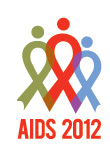 Most U.S. women at risk for HIV are unaware of PrEP—pre-exposure prophylaxis, which entails taking daily meds to prevent HIV—but they view it as an option that should be available to all sexually active women. What’s more, their chief rationale “had something to do with not trusting what men were up to.” Such were the findings of a qualitative, focus-group study of at-risk women presented by Judith Auerbach, PhD, research consultant to AIDS United and the San Francisco AIDS Foundation, during the XIX International AIDS Conference in Washington, DC.
Most U.S. women at risk for HIV are unaware of PrEP—pre-exposure prophylaxis, which entails taking daily meds to prevent HIV—but they view it as an option that should be available to all sexually active women. What’s more, their chief rationale “had something to do with not trusting what men were up to.” Such were the findings of a qualitative, focus-group study of at-risk women presented by Judith Auerbach, PhD, research consultant to AIDS United and the San Francisco AIDS Foundation, during the XIX International AIDS Conference in Washington, DC.
In 2009, women accounted for nearly 23 percent of new HIV infections in the United States, with black and Latino women being particularly at risk. As Auerbach said: “Clearly, more effective prevention strategies for women are needed.” One potential strategy is taking Truvada (tenofovir plus emtrictabine) as PrEP, which the Food and Drug Administration approved this summer. However, no clinical trials have focused on U.S. women; instead, trials have been primarily based in Africa, where results were mixed, likely because of low adherence to the regimen.
To gauge the knowledge and attitudes about PrEP among U.S. women, Auerbach and her colleagues organized focus group studies with a total of 92 women who perceived themselves to be HIV negative. Participants were considered to be at risk for the virus because of their social networks, sex and drug practices or socioeconomic status. Fifty-five percent were between 31 and 50 years old; 69 percent were black; 19 percent were Latino; 50 percent were employed; and 59 percent had at least some college. In addition, 27 percent perceived themselves at risk of getting HIV in the next year.
Focus groups were held in Washington, DC; Memphis, Tennessee; and Oakland and San Diego, California. Facilitators from local community groups recruited and led the focus groups, which began with background information about HIV and PrEP. Discussion topics included “For which women might PrEP be most helpful,” “Best sources of information about PrEP,” and “Potential impact of PrEP on women’s sex life, including use of condoms” among other subjects. Researchers then analyzed at the transcripts for underlying themes and to see if there were differences among the sites.
A range of opinions surfaced. “What’s really interesting,” Auerbach notes, “is the interaction that occurred during the course of the discussion. You can see a real divergence of opinion, and sometimes people would change their mind in the course of interaction with other women.”
One aspect was clear: Only about five out the 92 had heard of PrEP before the focus group. However, Auerbach said, “A number of women in all the groups mentioned that PrEP ought to be available for every woman, and chiefly the rational…had something to do with not trusting what men were up to.” They believed it was a helpful option for a range of women—sex workers, women whose partners have been in prison, women who experience sexual violence, black and Latino women—and for a variety of reasons. One woman suggested giving it to teens, noting the pregnancy rate as proof that unprotected sex was going on among youth. Another participant worried that giving young women PrEP would encourage them to be promiscuous.
Concerns about PrEP included efficacy, availability, adherence, side effects and the cost. “We have to be realistic about…the socio economics of our community, the underserved,” one participant said: “It has to be free.”
A common theme the researchers encountered was the mistrust of men (“you don’t know if your partner is faithful to you”), along with mistrust of the government and the medical system (participants mentioned the legacy of the “Tuskegee situation” as well as conflicting data about hormone replacement therapy). This mistrust was more profound among the African-American women. In addition, some participants noted that the church, specifically in the South and in rural America, would hinder PrEP as well as frank discussions about sex and HIV.
Participants suggested that trusted medical providers, community organizations and Planned Parenthood would be good venues through which to get PrEP to women, but it was noted that if PrEP is marketed only to black women, it might be viewed as a conspiracy.
Members of the focus groups were asked whether they thought women and men on PrEP would continue to use condoms. Opinions varied, Auerbach said, but the women were aware of other sexually transmitted infections and they mentioned that as a reason to continue condom use. Others felt it was likely that both men and women on PrEP would skip the condoms.
What was clear throughout the discussions, Auerbach said, was that women desired to have some way that they control their sexual health, especially since they didn’t trust their male partners. “A majority [of participants] at some moment concluded that [PrEP] was a reasonable option.”
Advertisement
Advertisement
Advertisement






1 Comment
1 Comment